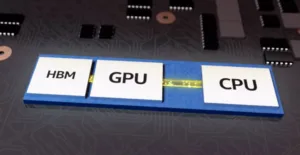As much as I hate to give Kyle Bennett of HardOCP credit for anything other than being fastest driver in Texas, it turns out he may also be the fastest news reporter too.

Way back in July 2016 when Nvidia was telling the us how great their new Polaris GTX thingies were, Kyle alerted the world to the crazy idea that Intel would use AMD graphics. Kyle has said some pretty crazy things over the years, but he been right more than he’s been wrong, and you don’t get to build crazy fast cars if no one listens to you.
In May of this year, also reliable news reporter Fuad (Fudo) Abazovic in his new portal, Fudzilla, confirmed the deal. Of course, neither AMD or Intel would deny nor confirm the speculations. It sort of reminded me of the year or so leading up to the acquisition of ATI by AMD.
Well AMD and Intel are out of the closet now, and it is an amazing story. Kyle and Fudo were right, maybe more than they knew. Intel will be buying chips from AMD, and then using their amazing manufacturing capabilities marrying the AMD semi-custom GPU, with HBM2, and 8th gen H-series CPUs into a super-thin package that will enable OEMs to build a thin and light enthusiast notebook, not 26 mm thick as they are today but approaching 15 to 16 mm, like a mainstream “thin & light” (T&L) notebook. They are not pushing this product into the mainstream T&L segment rather, they are bringing the mainstream T&L form factor to the enthusiast segment. This is science fiction coming true.
You Need a Trick or Two
One of the tricks Intel is employing to make this magic is Embedded Multi-Die Interconnect Bridge (EMIB) that’s impeded within the package to allow the GPU and memory to talk with each other. That got the disparate devices (HBM2, CPU, GPU) talking to each other as fast as an electron could move down a wire, but that was only part of the equation.
Intel’s and AMD’s chip talk to each other and the memory via a special bus (EMIB)
When you run a high-performance machine, you’ve got to be damn careful about how it uses power. You don’t want a $1,000 chip melting or turning itself off like the Flux Capacitor in Dr. Emmett Brown’s DeLorean DMC-12 because it runs too hot. Intel has that covered and is spreading its dynamic power management software all over this multi-chip delight.
By welding together these powerful components, Intel is saving 1900 mm² (~ 3-in sq.) of system board space, which makes cooling better, and allows for a larger battery.
This is not an IP licensing deal as some had speculated. AMD will be selling and shipping semi-custom chips to Intel. Intel will source the memory separately. Intel went with AMD because they liked how AMD integrated HBM2 into the Radeon architecture, and admired AMD’s custom experience.
Formalities Signal a Turning Point
Intel will formally announce and name this new part in Q1’18, and begin shipping later in 2018. This is a major turning point in the industry, and I think a proud moment for Intel. The company has done a tremendous job with the HD series on integrated GPUs, but you simply can’t get enthusiast-class performance with a shared-memory narrow bus-width memory, and Intel knows that as well as anyone.
However, you can’t jam a 250W PCIe AIB into a thin and light notebook either. So Intel did what they are so good at, making an engineering decision and exploiting their strengths, and have come up with what looks like will be a killer product for the high-end enthusiast market.

